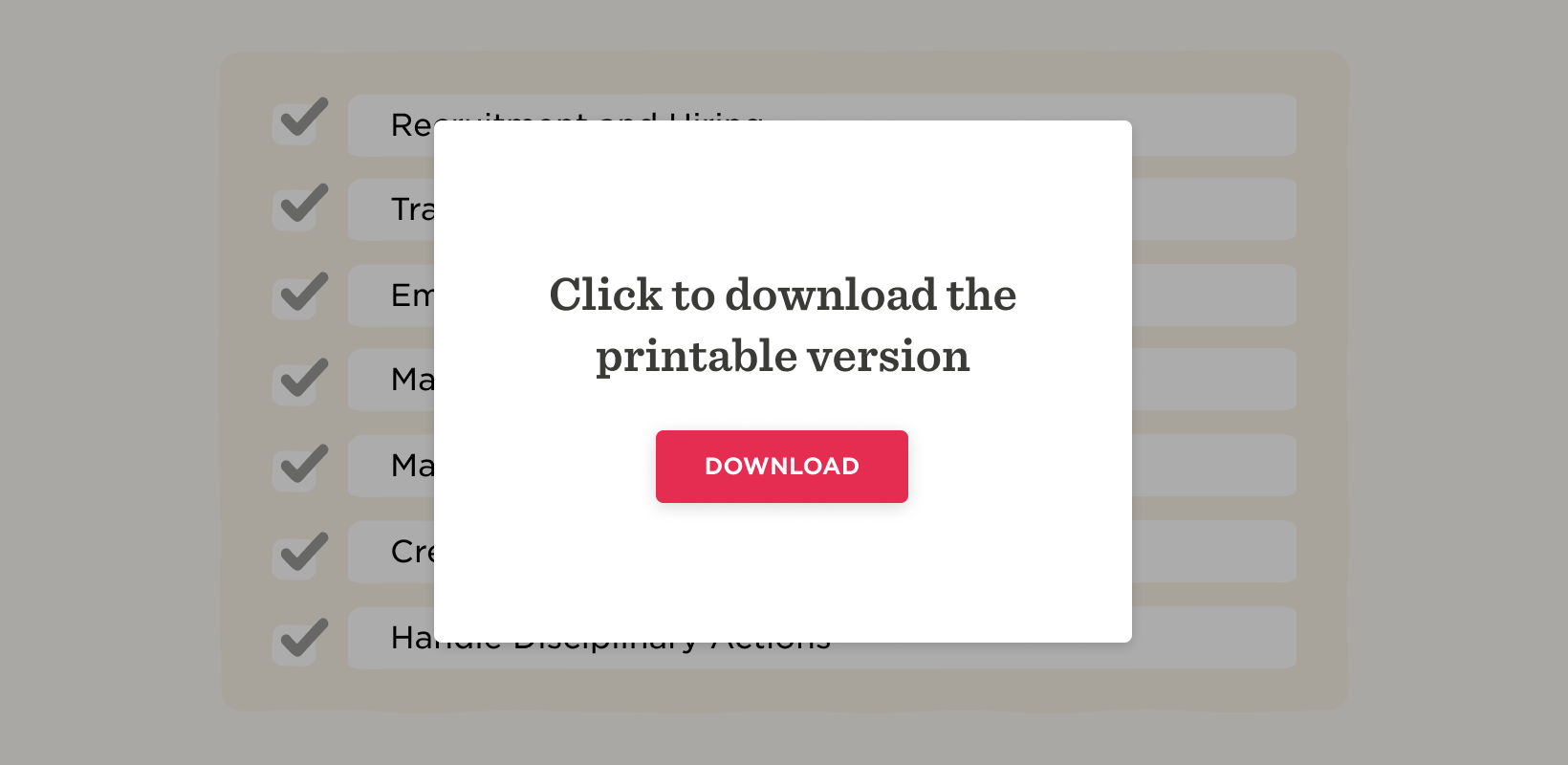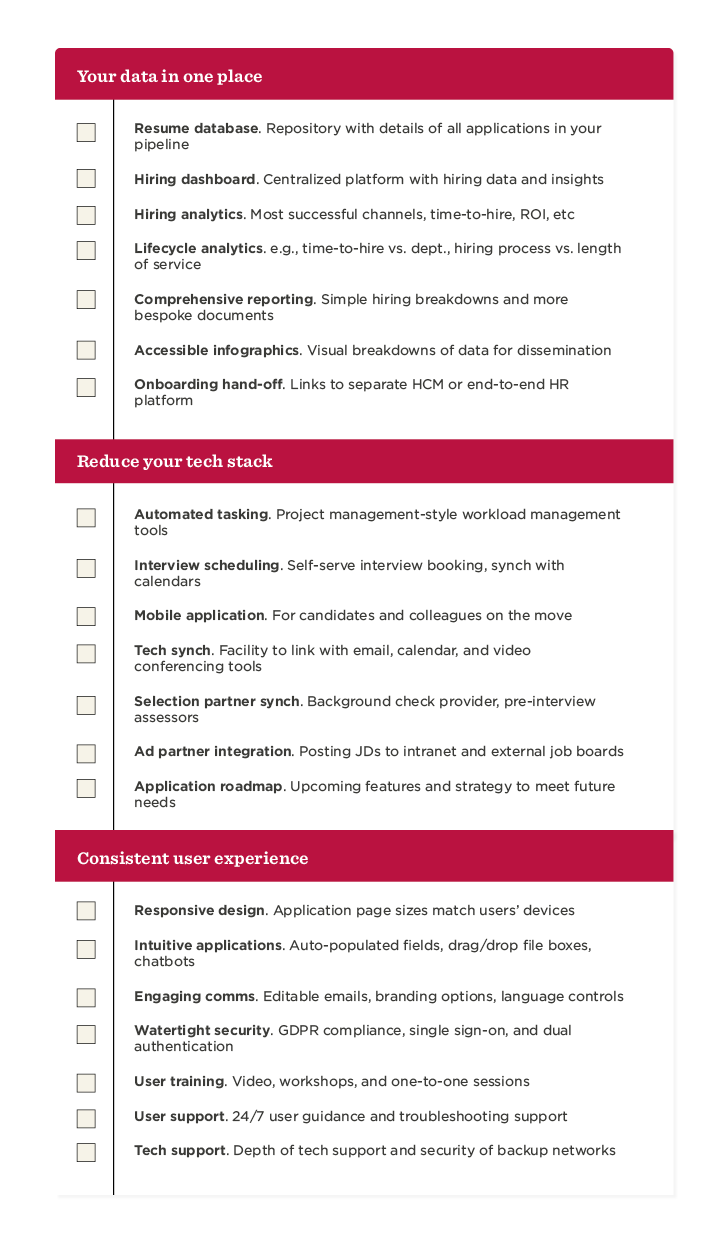An applicant tracking System (ATS) can be one of the keys to your success as an HR leader, regardless of your organization’s size, history, or industry.
A bold statement? Yes, but one easily proved.
Not sure what an ATS does? Put simply, an ATS manages the hiring process and helps you recruit the right people into the right teams at the right times. As you might imagine, this means a more seamless, engaging, and efficient hiring experience for candidates and colleagues.
But more than this, an applicant tracking system’s features can centralize your data, acting as a one-stop shop for all things recruitment. Some employers then integrate their ATS with their wider human capital management (HCM) software and systems to add another dimension to their data analysis.
The gold standard is when an employer uses a ‘hire-to-retire’ approach—using a single platform, like an HCM that includes an ATS, to hire and onboard candidates and engage, develop, and eventually offboard employees.
Having one system supporting the entire employee lifecycle means fewer systems and software, which usually leads to impressive cost, training, and provider support benefits.
However, not all ATS are the same. Different providers’ ATS offer different features, support different stretches of the hiring process, and, of course, require different levels of time and financial investment.
So, it’s vital that you choose your ATS carefully.
At a minimum, a good ATS makes hiring simpler for your HR team and speeds up the administrative elements of the process. Pick the wrong ATS, though, and you may need help to get straightforward tasks done, put good candidates off with poor comms, or lose the perfect candidate through cracks in your system.
The solution? This applicant tracking system features checklist. It’s a play-by-play of what the market has on offer as a whole, so you can laser in on what you really need and the ATS platforms that provide it.

Selecting the right applicant tracking system
It doesn’t matter whether you’re a startup or a large organization with offices around the globe. The challenge of choosing an ATS provider is simpler when you take a three-step, resource-discover-align approach.
Step one: resource a team
It won’t come as a surprise that things get done if your people have clearly-defined responsibilities in the procurement process. However, the individuals you choose to pick out the right ATS can greatly affect the result.
You need HR leaders who’ll keep hiring strategy front-of-mind. However, HR ‘doers’ should also be included, as they understand the day-to-day challenges and can see how an ATS will work in practice. Then, there are other specialists: from IT, to ensure the ATS will integrate smoothly, and procurement or finance, to make sure you get value for money.
Step two: discover your hiring requirements
Once your team’s in place, speak to stakeholders across the business to determine what different departments and managers want from an ATS. These conversations should be two-way streets: use this checklist to explain the ATS tools and features available and how they can improve the way you hire.
Pretty soon, you should have an ATS requirements document listing your must-have features. Keep coming back to it as you map out exactly what the final ATS (and your hiring process) might look like.
Step three: align your requirements with your ATS provider
With so many ATS providers out there, that carefully developed requirements document will start paying dividends immediately as you use it to select providers whose ATS can match your list of requirements.
Naturally, compromises might need to be made. Expect to cull some less-important requirements to create a shortlist of capable ATS candidates.
<< Click to download a printable PDF of this checklist >>
ATS features: understanding their breadth and impact on your organization
An ATS’ features, while varied, can be broadly filed together under three different areas.
An ATS can put all your data in one place, giving you better visibility of your hiring projects and candidate pipeline. The best ATS then harnesses this data to give you better management information and insights. These insights can be exponentially more powerful if your hiring data is merged with your wider employee data streams, as part of a hire-to-retire setup.
An ATS usually leads to a tech stack reduction: so everyone uses a single piece of hiring software rather than a collection of spreadsheets, packages, and applications. This cuts out manual tasks for hiring teams and streamlines operations (just the administrative and collaborative elements. No one’s built an ATS yet that can make sure stakeholders take actions the instant they’re required!).
Lastly, ATS features improve candidate experiences. There’s more to this than well-formatted offer and rejection emails. Things like pre-filled forms and responsive design make the process of applying for roles simpler and more engaging—improving the perception of your employer brand and helping you stand apart from rival employers. Equally, your hiring teams get a better experience, helping them work and collaborate more efficiently and effectively.
Look for an ATS that allows you to have all your data in one place
Lighthouse Research & Advisory 2024 Talent Acquisition Trends Study showed that 56 percent of all employers and 75 percent of SMEs struggle to keep accurate and consistent recruitment data because they use multiple systems.
It’s difficult to use this disjointed information. Effectively, you’re comparing apples with pasta. You can’t draw proper conclusions or back up strategy with proven facts. It’s also a key reason why less than half of all companies provide talent acquisition metrics to their Boards.
An ATS streamlines this workflow. It provides a single source of truth for your HR professionals, hiring managers, talent acquisition specialists, finance colleagues, and financial planning and analysis strategists. You can link hiring to performance and retention, and hiring operations can properly align to wider businesses resourcing plans.
As part of a hire-to-retire platform, an ATS can complete the map of your entire employee lifecycle—bringing recruitment and retention together to deliver compelling insights.
Look for an ATS that reduces your tech stack and creates more efficient processes
According to industry analyst Josh Bersin, “The average large company has 80+ HR tools and many global companies have twice that!”. That’s a lot of time and money wasted on procurement, implementation, licenses, and training.
This excludes the constant refocusing of minds, the switching between systems, the different forms of collaboration, and the processing of all your data, comms, and content. With 54 percent of companies expecting an increase in hiring volumes this year (according to Lighthouse Research & Advisory 2024 Talent Acquisition Trends Study), you have a perfect storm of tech slowdown where systems and processes hinder, rather than help, your people.
With just one ATS (or wider hire-to-retire platform), employers can save money by cutting subscriptions to multiple applications. Operations are streamlined, so colleagues can pick up (and run) processes quicker.
Security is naturally tightened, as your data is with fewer providers. Plus, your people can focus more on collaborating and giving candidates a better experience. In fact, it’s the #1 way employers who find automation efficiencies are reinvesting that time.
Look for an ATS that provides a consistent user experience, both for internal users and candidates
When looking at your ATS options, it’s worth noting Matt Ferguson’s (CEO CareerBuilder) take on matching your requirements to an ATS’ features: “Companies are willing to accept less functionality just to have their technology with a single platform.”
This is where it helps to step back, look at the bigger picture, and make sure your platform’s easy to adopt and gets everyone on board.
For users, an all-in-one, hire-to-retire HCM platform that includes an ATS means just one system for them to learn, log into, and manage. In terms of hiring, this frictionless process makes it easier for colleagues to engage more deeply activities, collaborate at speed, and get access to your HR team’s methods and advice.
On the candidate side, a disjointed application process increases the risk they’ll drop out of your process. A joined-up, consistent, on-brand candidate journey shows employers in their best light.
Candidates find it easier to grasp what you stand for, and those who share your values will then be more inclined to make you their employer of choice. Conversely, poor experiences can potentially lead to candidates misjudging who you are, leading to wrong-fit hires.
Looking beyond simply being better at hiring, here’s a really interesting stat: according to Lighthouse Research & Advisory 2024 Talent Acquisition Trends Study, only 15 percent of companies say they have a highly personalized, engaging, and compliant onboarding process. That’s an opportunity to have a competitive advantage over 85 percent of the employment market.
Applicant tracking system requirements checklist

<< Click to download this list as a PDF >>
Recommended For Further Reading
What to consider when implementing an ATS within your HCM strategy
When introducing a new or switching to a different ATS, it’s important to consider how it fits alongside the rest of your human capital management software.
The big questions to ask are around how much impact it will have and whether there are any potential gains (or reductions) with economies of scale. There are three main ways to implement an ATS: standalone, unconnected to any other HR tools; integrated with a different HCM; or as part of an end-to-end HCM solution.
A standalone ATS still elevates your hiring activities—and is likely to give your team the ability to advertise, filter, interview, select, and offer with ease. However, when integrated with another HCM, there’s the added potential of merging datasets across the employee lifecycle and mining ever-stronger management information.
This power is enhanced even further when the ATS is one tool within an end-to-end HCM solution, providing seamless comms, comprehensive MI, and possible savings when compared to working with multiple providers.
An ATS is your ticket to achieving hiring success
Huge numbers of leading organizations use ATS software in one form or another. Many of these systems provide great returns—saving HR teams’ time and improving hiring ROI. However, their influence doesn’t have to stop there.
Additionally, an ATS can give HR leaders (and their teams) greater visibility of the hiring process, helping to smoothly roll out resourcing strategies. Having all your data in one place can also provide detailed insights that evolve those strategies.
Then, there are the benefits of using a unified system. Reducing your tech stack not only reduces the time it takes to administer hiring process. It helps people across your organization engage more easily with hiring practices.
Finally, there’s the consistent user experience. An ATS can basically make an employer look good and, if your ATS is part of an end-to-end solution, it’s a look that continues into employment.
When delivered by a provider who also offers great support and flexibility, an ATS is more than simply an administrative tool. It helps you find, win over, and onboard the very best talent. More widely, it informs, guides, and reacts to the evolving needs of your HR strategy.
For many HR leaders, their ATS is the best hire they’ve ever made.